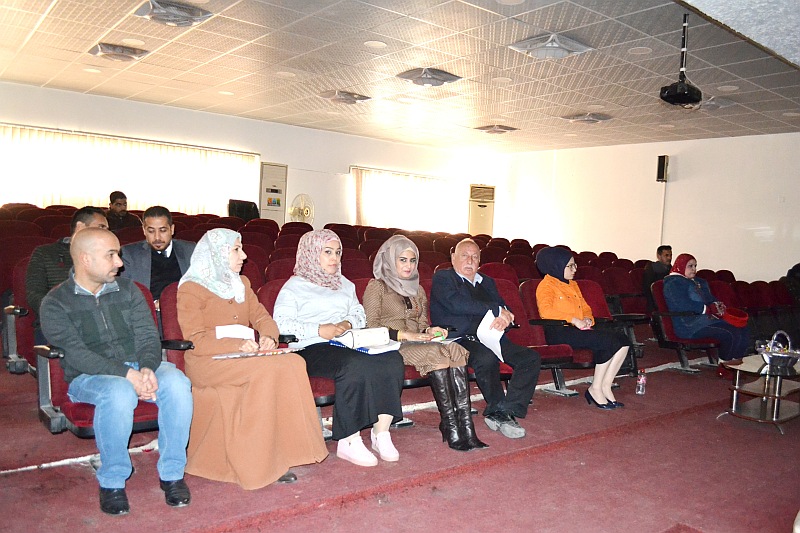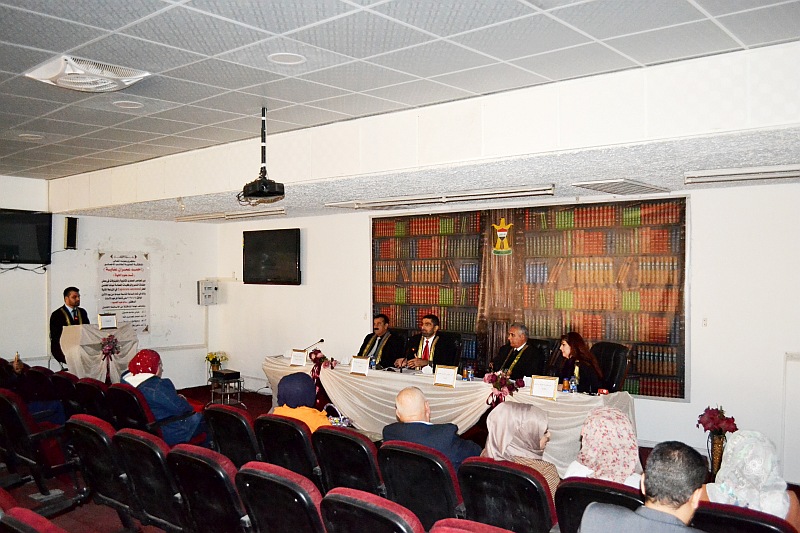جرت على قاعة المرحوم الدكتور سالم عبد الحميد في المناقشة العلنية لرسالة طالب الماجستير احمد عمران عناية الموسومة :
دور العناصر الصغرى النانوية والفينولات في بعض صفات النمو والمركبات الفعالة لنبات الفلفل الحار Capsicum annuum L. في الزراعة المائية
حيث تألفت لجنة المناقشة من التدريسيين الأفاضل :
أ.د . عباس جاسم حسين رئيسا
أ.م.د . احمد نجم عبدالله عضوا
أ.م.د .سميرة مؤيد ياسين عضوا
ا.م.د.ماهر زكي فيصل عضوا ومشرفا
اُختيرَ البيت الزجاجي التابع لقسم علوم الحياة – كلية التربية للعلوم الصرفة (ابن الهيثم) – جامعة بغداد موقعاً لتنفيذ التجربة خلال موسم النمو 2017 – 2018 باستعمال وحدة المزارع المائية لتنمية شتلات الفلفل الحار Capsicum annum (L.) بهدف معرفة دور العناصر الصغرى النانوية بالتراكيز (0 و 5 و 10 و 20 و 40) مايكروغرام. لتر-1، والفينولات بالتراكيز (0 و 0.1 و 0.2 و 0.3 و 0.4) مل. لتر-1 على بعض صفات النمو والمركبات الفعالة للنبات.
اعتُمِدَ التصميم العشوائي الكامل Completely Randomized Design (CRD) لتجربة عاملية، وبثلاثة مكررات (5 تراكيز العناصر الصغرى النانوية × 5 تراكيز الفينولات × 3 مكررات) متضمنةً التجربة بذلك 75 وحدة تجريبية. واعتُمِدَ في مُقارنة المُتوسِطات اختبار أقل فرق معنوي Least Significant Difference (LSD) عندَ مُستوى احتمال (P ≤ 0.05)، وكانت نتائج التجربة ما يأتي:
-
التأثير المعنوي للعناصر الصغرى النانوية بالتركيز 20 مايكروغرام. لتر-1 في زيادة ارتفاع النبات، وقطر الساق، وحجم الجذر، وعدد الأوراق، والمساحة الورقية الكلية، وعدد الأفرع، والأوزان الطرية والجافة للمجموعين الخضري والجذري، ومعدل النمو المطلق، واستدامة الكتلة الحيوية، ومحتوى كل من الحديد والزنك والمنغنيز والنحاس والبورون، وعدد الثمار ووزنها الطري ونسبة الكربوهيدرات، ومحتوى فيتامين C، وتراكيز المركبين الفعالين Capsaicin و 2-dihidrocapsaicin. فيما سجَّلَ التأثير المعنوي للتركيز 10 مايكروغرام. لتر-1 زيادة محتوى النتروجين والفسفور والبوتاسيوم ونسبة البروتين ومحتوى الكلوروفيل. أما التأثير المعنوي للتركيز 40 مايكروغرام. لتر-1 فاقتصرَ على طول الجذر وتركيز المركبين الفعالين Nonivamide و 4,4-Dimethyl-2-pentanone في الثمار.
-
استعمال الفينولات رشاً على المجموع الخضري بالتركيز 0.2 مل. لتر-1 كانت ذات تأثير معنوي في زيادة ارتفاع النبات، وقطر الساق، وطول الجذر، وعدد الأفرع، والوزنين الطري والجاف للمجموع الخضري، ومحتوى النتروجين، ومحتوى كل من الحديد والزنك والمنغنيز والنحاس، ونسبة البروتين، ومحتوى الكلوروفيل، وعدد الثمار ووزنها الطري ونسبة الكربوهيدرات فيها ومحتواها من فيتامين C، وتراكيز المركبات الفعالة Capsaicin و 2-dihidrocapsaicin و Nonivamide و 4,4-Dimethyl-2-pentanone في الثمار. في حين كان التركيز 0.3 مل. لتر-1 ذات تأثير معنوي على حجم الجذر، والوزنين الطري والجاف للمجموع الجذري، ومعدل النمو المطلق، واستدامة الكتلة الحيوية، ومحتوى كل من الفسفور والبوتاسيوم والبورون، وعدد الأزهار. أما عدد الأوراق والمساحة الورقية الكلية فكانت زيادتهما بتأثير أعلى تركيز مستعمل من الفينولات 0.4 مل. لتر-1.
-
التركيز 20 مايكروغرام. لتر-1 من العناصر الصغرى النانوية مع 0.2 مل. لتر-1 من الفينولات حقق زيادة معنوية في ارتفاع النبات، وقطر الساق، وعدد الأفرع، والوزنين الطري والجاف للمجموع الخضري، ومحتوى كل من الحديد والزنك والمنغنيز والنحاس، وعدد الثمار ووزنها الطري، ونسبة الكربوهيدرات، ومحتوى فيتامين C، وتركيز المركبين الفعالين Capsaicin و 2-dihidrocapsaicin في الثمار.
-
التركيز 20 مايكروغرام. لتر-1 من العناصر الصغرى النانوية مع 0.3 مل. لتر-1 من الفينولات أثَّرَ معنوياً في زيادة حجم الجذر، والوزنين الطري والجاف للمجموع الجذري، ومعدل النمو المطلق، واستدامة الكتلة الحيوية، ومحتوى البورون.
-
التركيز 10 مايكروغرام. لتر-1 من العناصر الصغرى النانوية مع 0.2 مل. لتر-1 من الفينولات حقق أعلى محتوى للنتروجين، ونسبة للبروتين ومحتوى للكلوروفيل. بينما حقق التركيز 10 مايكروغرام. لتر-1 من العناصر الصغرى النانوية مع 0.3 مل. لتر-1 من الفينولات أعلى محتوى لكل من الفسفور والبوتاسيوم، وعدد الأزهار.
-
التركيز 20 مايكروغرام. لتر-1 من العناصر الصغرى النانوية مع 0.4 مل. لتر-1 من الفينولات كان الأفضل معنوياً على صفة عدد الأوراق والمساحة الورقية الكلية.
-
التركيز 40 مايكروغرام. لتر-1 من العناصر الصغرى النانوية مع 0.2 مل. لتر-1 من الفينولات سجل أعلى تركيز للمركبين الفعالين Nonivamide و 4,4-Dimethyl-2-pentanone في الثمار.





